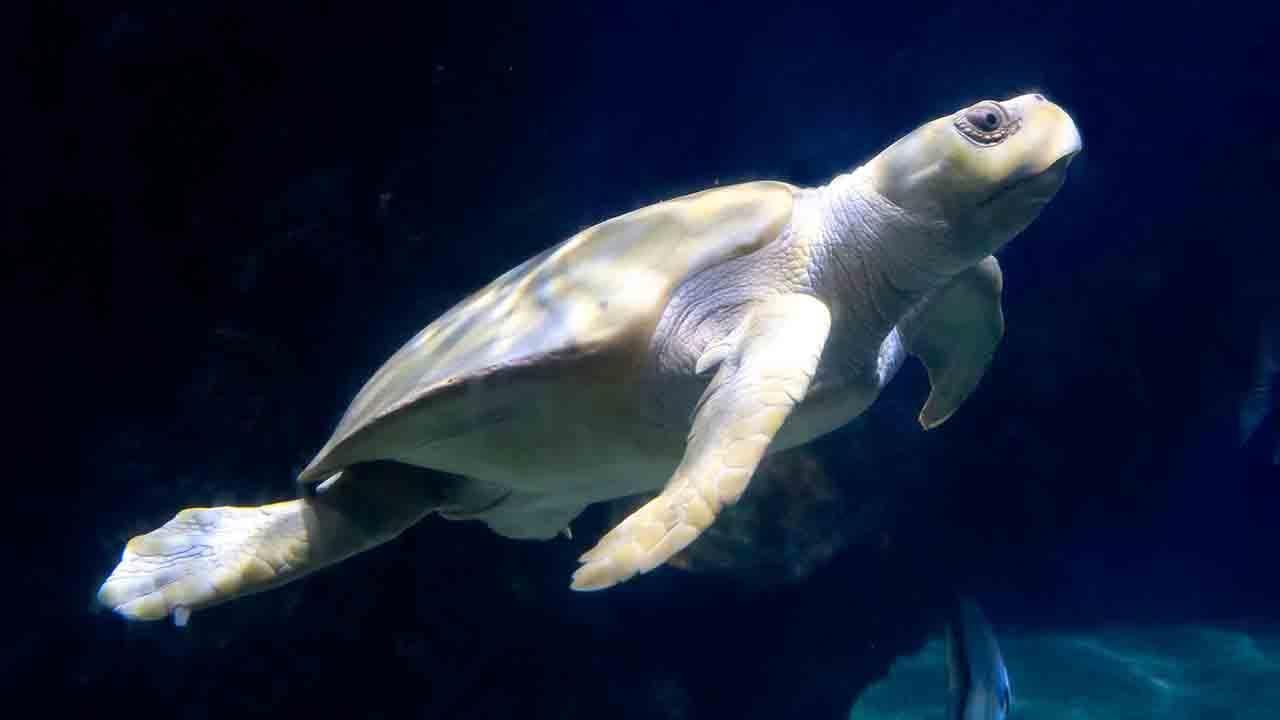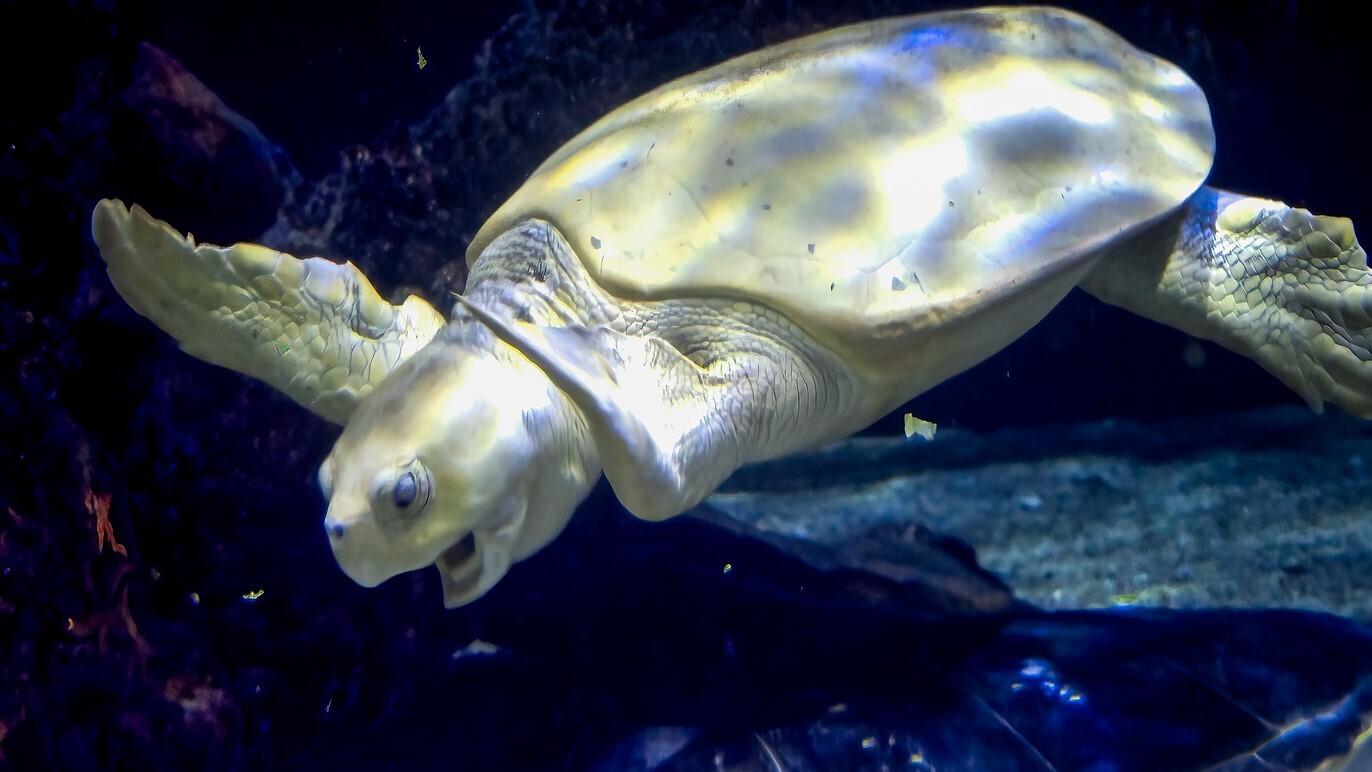Length: 24-27 inches
Weight: Approximately 100 pounds
Kemp's ridley sea turtles are considered the smallest species of sea turtle in the world. Their head is triangular in shape with a strong, hooked beak. Like other sea turtles (but unlike freshwater terrapins and tortoises), Kemp's ridley sea turtles have flippers in place of feet, and each front flipper has one claw while back flippers have one or two claws.
Scutes
A turtle's shell is comprised of large, hard scales called scutes. Like human fingernails, scutes are made from keratin and they grow as the turtle grows.
While Kemp's ridley hatchlings are completely black on both the carapace (top shell) and plastron (bottom shell), adults have a circular gray-green carapace with 5 pairs of scutes running along the outer edges and a creamy-colored plastron.
Diet
Kemp's ridleys have powerful jaws that help them crush crab shells, shrimp, and the hard shells of bivalves like clams and mussels. Kemp's ridley sea turtles also enjoy fish, sea urchins, squid, and jellyfish.
Habitat
Kemp's ridleys are often found feeding in estuaries, and especially favor hunting in shallow areas with seagrasses and muddy or sandy floors. Nesting females prefer sandy beaches that are located near swamps or larger bodies of open water.
While the juveniles can be found all along the east coast of the United States, between tropical and temperate coastal areas of the Northwest Atlantic, adults are usually limited to the warmer waters of the Gulf of Mexico.
Reproductive Behavior
A Kemp's ridley turtle reaches sexual maturity between 10 and 15 years of age, at which time the females will return to nest on the same beach from where they hatched. Nesting season is generally from April to July. While they come ashore to nest more frequently than other sea turtle species, they only nest every 1 to 3 years.
Kemp's ridley females are unique in that they come ashore to lay eggs during daylight hours, as opposed to nighttime. They congregate offshore and then all come onto the beach together, in what is called "arribadas," which is Spanish for "arrival." They nest on average 2-3 times each season. Each time the female will dig a hollow with her hind flippers and then lay 50 to 200 golfball-sized eggs in the nest before covering the nest with sand. The entire process might take 1 to 3 hours.
The females, after covering the eggs will even take extra care to tamp down the nest and flick extra sand around to hide signs of the nest.
Hatchlings
The clutch will incubate for about 50-60 days. After hatching, the half-ounce, 1.5-inch hatchlings emerge from the nest in the middle of the night. They then use the skylight reflecting off the water as a guide. Hatchlings that successfully reach the ocean will swim out into deeper water (though rarely deeper than 160 feet) where they will stay for the next developmental stage of their lives until ready to mate.
Light pollution is an issue for hatchlings because the light from a streetlight, a beach house, or even headlights from a car can disorient them, causing them to travel in the wrong direction when time is of the essence. Hatchlings that do not make it to the water by daybreak can be targeted by predators or die in the hot sun.
Concerns
This species was listed as Endangered in 1970 under the US Endangered Species (Conservation) Act, but internationally it is listed as Critically Endangered.
Humans continue to be the Kemp's ridley's greatest threat. Initially, overhunting for eggs, meat, and turtle parts led to their decline, but even greater numbers have been lost as a result of accidental capture by commercial shrimp trawlers, as well as other unsustainable fishing practices.
Celebrations
Kemp's ridley sea turtles, though the most endangered of all sea turtle species, are internationally protected through treaties and laws. In Mexico, significant efforts have been made to protect the species's critical nesting areas. NOAA's National Marine Fisheries Service partners with the US Fish & Wildlife Service to regularly monitor turtle populations. Regulations have been established that limit human traffic and fishing in protected nesting areas, and conservationists work to monitor nests during nesting season.
Even modifications in fishing gear have led to fewer turtle fatalities as a result of accidental (bycatch) capture by commercial and sport fishermen. Additionally, here in Hampton Roads, our Stranding Response team cares for numerous Kemp's ridleys injured by recreational fishing gear like nets and hooks.


